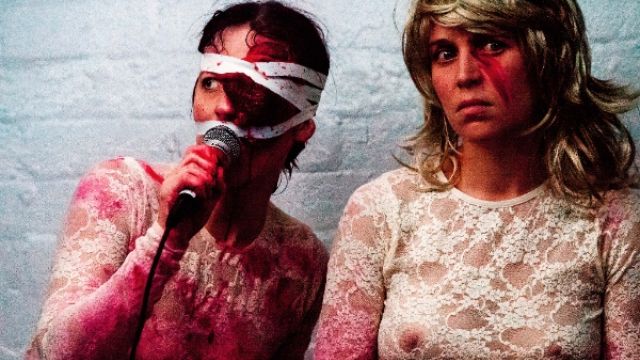Cain and Abel
Cain and Abel: the Biblical, archetypal figures of fraternal conflict. A story, say this show’s creators in their program notes, that has gone ‘beyond its religious beginnings… [and] has defined our contemporary understanding of violence’. This very bloody production seeks to question stereotypes and the roots of masculine violence.
It’s not a question of ‘What would happen if Cain and Abel were sisters?’ If Cain and Abel were sisters, wouldn’t it be a different story? (Maybe not.) No, here the idea seems to be ‘what do we make of the Cain and Abel story if the brothers are played by two women?’ Thus two women act out the ‘first murder’ and we are invited to see it – and acts of violence down the ages – with a new perspective.
The Biblical text - of the birth of Cain and Abel, of their professions and of Abel’s murder - is projected on a transparent screen. Behind it, Cain (Dana Miltins), the gardener, and Abel (Mary Helen Sassman), the shepherd, appear. Although we know what to expect, we are, for a moment, confused by these two women as the first brothers – especially as they both wear long cotton skirts, suggesting something 19th century and rural. Set and costume design are by Kate Davis while director Emma Valente designed the effective lighting and the rather overpowering soundscape.
What also confuses in this myth is that God – Yahweh – is the real culprit. All powerful God might have said to the brothers, ‘Well done, lads.’ Instead, He makes trouble: He decidedly prefers Abel’s sheep sacrifice to Cain’s fruit and veg. Here’s another fundamental myth of a nomadic people in transition. The shepherd – a ‘masculine’ activity – is praised above the ‘feminine’ grower (nurturer) of crops. The male is dominant; thus Cain is shamed. He reacts by killing his brother. God brands him with ‘the mark of Cain’ and casts him out to live among the people of the Land of Nod. (I am not the first to wonder where they came from. Perhaps the chronicle omits God making them while Cain and Abel are growing up.) The mark of Cain, however, is a punishment, but also, in effect, the mark of shame. The shame will provoke men to more violence.
But in Part Two (‘Honour’), we shift to a lament by a Warrior/Abel that he has lost his Honour – i.e. he is shamed, he has failed – so he must be killed… by another Warrior/Cain. Is it a case of ‘letting the side down’? Part Three (‘Domestic’), has a contemporary and very topical setting for a scene of domestic violence. Homemaker/Abel is shamed by having let himself/herself be humiliated at a supermarket and so… But that shaming comes across as the thin excuse for a spewing of male clichés of resentment, towering rage and the horrific murder that follows. Yet again, the motive differs from why Cain killed Abel. Is this Cain shamed because this Abel was shamed?
In Part Four (‘Spectacle’), there is glitz and gladiatorial combat and exultant gestures of triumph and the humiliation of the defeated – who must be killed – killed that is, were the underlying hatred and desire to obliterate allowed full rein. The carnage is rewarded, sanctified even, by showers of gold.
In the course of this, Ms Miltins and Ms Sassman demonstrate that they are skilled physical actors with a capacity for comedy that is a relief and surprising in this context.
Judging by the descriptions given in reviews (mostly negative) of the show’s 2014 outing at Belvoir Street, Sydney, much has changed in terms of presentation and production. There appears to be more dialogue; action inside a hazy Perspex box is gone. The fundamental concept, however, remains and we can guess that the underlying ideas are clearer now than they appeared to have been in the original production.
And there are ideas here. There is Ms Miltins and Ms Sassman playing male mythic or stereotypical figures. There is the stage hung with boxers’ punching bags, suggesting a perpetual world of male aggression and competition. And there is the idea that victims bleed and that blood-lust underlies male rituals (such as sport), so there is blood and there is more and more blood, until the stage is smeared with it and Ms Miltins and Ms Sassman (in particular) are drenched in it.
While these ideas are each manifested graphically and forcefully, I couldn’t help asking myself if they are of enough insight and substance even for the bare fifty minutes this show runs. (As a sign of my disengagement, I worried about the stage manager, Sarah McKenzie, who presumably has to mop up all that blood and wash the costumes for the next show.)
Has the Cain and Abel story ‘defined our contemporary understanding of violence’? While Cain and Abel gives us a range of insights into male violence, I was not convinced by that assertion when I read the program and am still not by the show itself. ‘Boldly ignoring linear and dominant systems of representation’ (to quote the program again) is admirable – provided communication rather than confusion and impatience is achieved. The Rabble company has been making theatre for over ten years – provocative, imaginative and feminist theatre – but this show suggests a hermetically sealed and self-endorsing collaboration that could do well to let in some air and light.
Michael Brindley
Subscribe to our E-Newsletter, buy our latest print edition or find a Performing Arts book at Book Nook.

